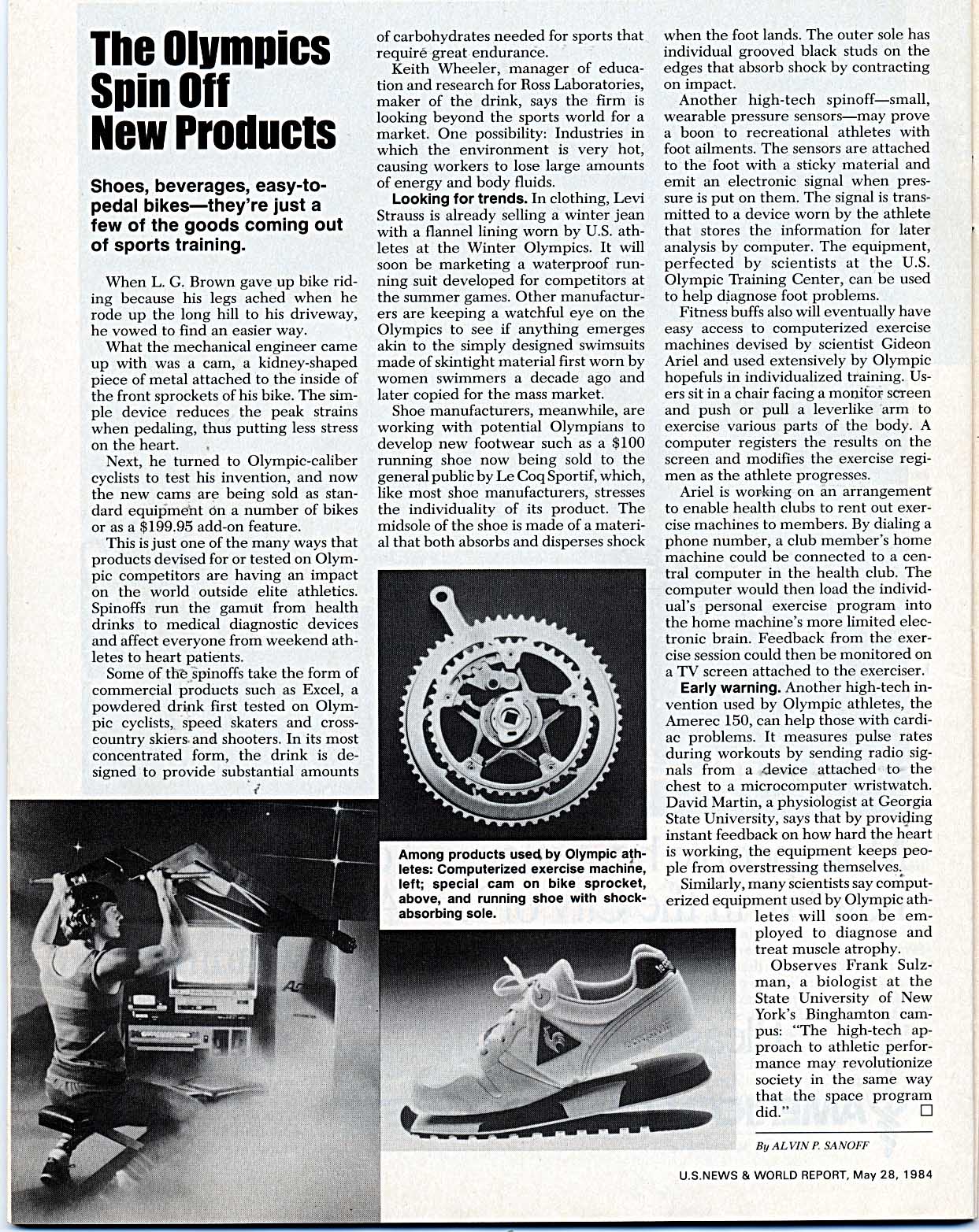The Olympics Spin Off New Products
Shoes, beverages, easy-topedal bikes-they're just a few of the goods coming out of sports training
By Alvin Sanoff in U.S. News on Tuesday, May 1, 1984
Article Synopsis
The article, published on May 28, 1984, discusses the impact of the Olympics on product development and innovation. It highlights how products designed for or tested on Olympic athletes are influencing the wider market. Examples include a cam device for bikes that reduces strain on the heart, a powdered drink designed for endurance sports, and a waterproof running suit. The article also mentions the development of high-tech products such as wearable pressure sensors for diagnosing foot problems, computerized exercise machines for personalized training, and a device that measures pulse rates during workouts. The article concludes by suggesting that the high-tech approach to athletic performance could revolutionize society in a similar way to the space program.
Tip: use the left and right arrow keys
MAY 28,1984 $1.75
&WORLD RePORT
Real Loser in Olympics Boycott: The Kremlin Itself
How to Eat Well and Stay Healthy Medical Authority Advice From a
The Olympics Spin Off New Products
Shoes, beverages, easy-topedal bikes-they're just a few of the goods coming out of sports training.
When L. G. Brown gave up bike riding because his legs ached when he rode up the long hill to his driveway, he vowed to find an easier way.
What the mechanical engineer came up with was a cam, a kidney-shaped piece of metal attached to the inside of the front sprockets of his bike. The simpie device reduces the peak strains when pedaling, thus putting less stress on the heart.
Next, he turned to Olympic-caliber cyclists to test his invention, and now the new cams are being sold as standard equipment on a number of bikes or as a $199.95 add-on feature.
This is just one of the many ways that products devised for or tested on Olympic competitors are having an impact on the world outside elite athletics. Spinoffs run the gamut from health drinks to medical diagnostic devices and affect everyone from weekend athletes to heart patients.
Some of the spinoffs take the form of commercial products such as Excel, a powdered drink first tested on Olympic cyclists, speed skaters and crosscountry skiers. and shooters. In its most concentrated form, the drink is designed to provide substantial amounts
of carbohydrates needed for sports that require great endurance.
Keith Wheeler, manager of education and research for Ross Laboratories, maker of the drink, says the firm is looking beyond the sports world for a market. One possibility: Industries in which the environment is very hot, causing workers to lose large amounts of energy and body fluids.
Looking for trends. In clothing, Levi Strauss is already selling a winter jean with a flannel lining worn by U.S. athletes at the Winter Olympics. It will soon be marketing a waterproof running suit developed for competitors at the summer games. Other manufacturers are keeping a watchful eye on the Olympics to see if anything emerges akin to the simply designed swimsuits made of skintight material first worn by women swimmers a decade ago and later copied for the mass market.
Shoe manufacturers, meanwhile, are working with potential Olympians to develop new footwear such as a $100 running shoe now being sold to the general public by Le Coq Sportif, which, like most shoe manufacturers, stresses the individuality of its product. The midsole of the shoe is made of a material that both absorbs and disperses shock
Among products used by Olympic athletes: Computerized exercise machine, left; special cam on bike sprocket, above, and running shoe with shockabsorbing sole.
when the foot lands. The outer sole has individual grooved black studs on the edges that absorb shock by contracting on impact.
Another high-tech spinoff-small, wearable pressure sensors-may prove a boon to recreational athletes with foot ailments. The sensors are attached to the foot with a sticky material and emit an electronic signal when pressure is put on them. The signal is transmitted to a device worn by the athlete that stores the information for later analysis by computer. The equipment, perfected by scientists at the U.S. Olympic Training Center, can be used to help diagnose foot problems.
Fitness buffs also will eventually have easy access to computerized exercise machines devised by scientist Gideon Ariel and used extensively by Olympic hopefuls in individualized training. Users sit in a chair facing a monitor screen and push or pull a leverlike arm to exercise various parts of the body. A computer registers the results on the screen and modifies the exercise regimen as the athlete progresses.
Ariel is working on an arrangement to enable health clubs to rent out exercise machines to members. By dialing a phone number, a club member's home machine could be connected to a central computer in the health club. The computer would then load the individual's personal exercise program into the home machine's more limited electronic brain. Feedback from the exercise session could then be monitored on a TV screen attached to the exerciser.
Early warning. Another high-tech invention used by Olympic athletes, the Amerec 150, can help those with cardiac problems. It measures pulse rates during workouts by sending radio signals from a -device attached to the chest to a microcomputer wristwatch. David Martin, a physiologist at Georgia State University, says that by providing instant feedback on how hard the heart is working, the equipment keeps people from overstressing themselves..
Similarly, many scientists say coputerized equipment used by Olympic athletes will soon be employed to diagnose and treat muscle atrophy.
Observes Frank Sulzman, a biologist at the State University of New York's Binghamton campus: "The high-tech approach to athletic performance may revolutionize society in the same way that the space program did." 0
sy Ar.1TV r SJ% \Orr
U.S.NEWS & WORLD REPORT, May 28, 1984


